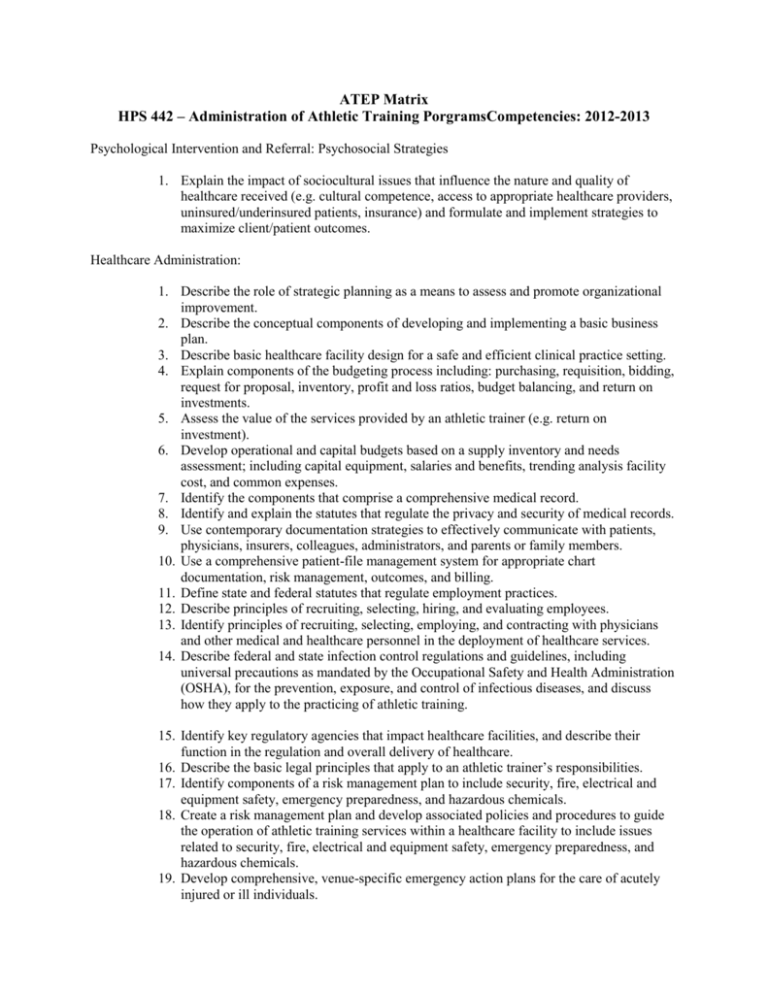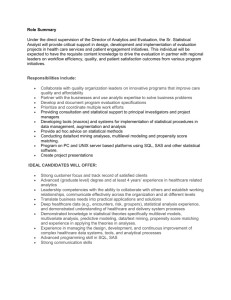HPS 442 - Administration of Athletic Training Programs
advertisement

ATEP Matrix HPS 442 – Administration of Athletic Training PorgramsCompetencies: 2012-2013 Psychological Intervention and Referral: Psychosocial Strategies 1. Explain the impact of sociocultural issues that influence the nature and quality of healthcare received (e.g. cultural competence, access to appropriate healthcare providers, uninsured/underinsured patients, insurance) and formulate and implement strategies to maximize client/patient outcomes. Healthcare Administration: 1. Describe the role of strategic planning as a means to assess and promote organizational improvement. 2. Describe the conceptual components of developing and implementing a basic business plan. 3. Describe basic healthcare facility design for a safe and efficient clinical practice setting. 4. Explain components of the budgeting process including: purchasing, requisition, bidding, request for proposal, inventory, profit and loss ratios, budget balancing, and return on investments. 5. Assess the value of the services provided by an athletic trainer (e.g. return on investment). 6. Develop operational and capital budgets based on a supply inventory and needs assessment; including capital equipment, salaries and benefits, trending analysis facility cost, and common expenses. 7. Identify the components that comprise a comprehensive medical record. 8. Identify and explain the statutes that regulate the privacy and security of medical records. 9. Use contemporary documentation strategies to effectively communicate with patients, physicians, insurers, colleagues, administrators, and parents or family members. 10. Use a comprehensive patient-file management system for appropriate chart documentation, risk management, outcomes, and billing. 11. Define state and federal statutes that regulate employment practices. 12. Describe principles of recruiting, selecting, hiring, and evaluating employees. 13. Identify principles of recruiting, selecting, employing, and contracting with physicians and other medical and healthcare personnel in the deployment of healthcare services. 14. Describe federal and state infection control regulations and guidelines, including universal precautions as mandated by the Occupational Safety and Health Administration (OSHA), for the prevention, exposure, and control of infectious diseases, and discuss how they apply to the practicing of athletic training. 15. Identify key regulatory agencies that impact healthcare facilities, and describe their function in the regulation and overall delivery of healthcare. 16. Describe the basic legal principles that apply to an athletic trainer’s responsibilities. 17. Identify components of a risk management plan to include security, fire, electrical and equipment safety, emergency preparedness, and hazardous chemicals. 18. Create a risk management plan and develop associated policies and procedures to guide the operation of athletic training services within a healthcare facility to include issues related to security, fire, electrical and equipment safety, emergency preparedness, and hazardous chemicals. 19. Develop comprehensive, venue-specific emergency action plans for the care of acutely injured or ill individuals. 20. Describe a plan to access appropriate medical assistance on disease control, notify medical authorities, and prevent disease epidemics. 21. Describe common health insurance models, insurance contract negotiation, and the common benefits and exclusions identified within these models. 22. Describe the criteria for selection, common features, specifications, and required documentation needed for secondary, excess accident, and catastrophic health insurance. 23. Describe the concepts and procedures for revenue generation and reimbursement. 24. Understand the role of and use diagnostic and procedural codes when documenting patient care. 25. Describe the role and functions of various healthcare providers and protocols that govern the referral of patients to these professionals. Professional Development and Responsibility: 1. Explain the role and function of state athletic training practice acts and registration, licensure, and certification agencies including (1) basic legislative processes for the implementation of practice acts, (2) rationale for state regulations that govern the practice of athletic training, and (3) consequences of violating federal and state regulatory acts. 2. Explain the process of obtaining and maintaining necessary local, state, and national credentials for the practice of athletic training. 3. Perform a self-assessment of professional competence and create a professional development plan to maintain necessary credentials and promote life-long learning strategies. 4. Differentiate among the preparation, scopes of practice, and roles and responsibilities of healthcare providers and other professionals with whom athletic trainers interact. 5. Develop healthcare educational programming specific to the target audience (eg, clients/patients, healthcare personnel, administrators, parents, general public). 6. Identify strategies to educate colleagues, students, patients, the public, and other healthcare professionals about the roles, responsibilities, academic preparation, and scope of practice of athletic trainers. 7. Identify mechanisms by which athletic trainers influence state and federal healthcare regulation. Clinical Integration Proficiency: 1. Utilize documentation strategies to effectively communicate with patients, physicians, insurers, colleagues, administrators, and parents or family members while using appropriate terminology and complying with statues that regulate privacy of medical records. This includes using a comprehensive patient-file management system (including diagnostic and procedural codes) for appropriate chart documentation, risk management, outcomes, and billing.





